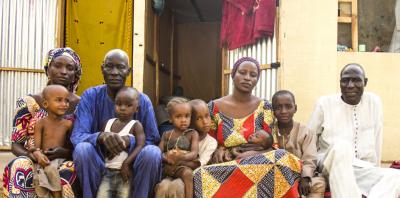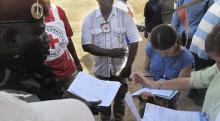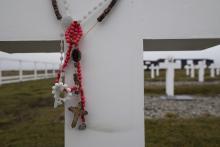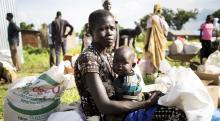Case prepared by Molly Wooldridge, J.D. student, and John Wamwara, L.L.M. student, at Emory University School of Law, under the supervision of Professor Laurie Blank, Emory University School of Law; with the contribution of Jemma Arman and Isabelle Gallino, LL.M. students at the Geneva Academy.
A. UNHCR ASSISTANCE AND MULTI-ENTITY COOPERATION
[…] Since 2011, the population in Nigeria has been affected by conflict between armed groups and governmental forces in the three north-eastern Federal States of Yobe, Adamawa and Borno. This has resulted in the killing and abduction of civilians, and the destruction of social and economic infrastructure in Nigeria. In May 2013, the Government of Nigeria declared a state of emergency with the imposition of curfews.
An inter-agency assessment mission fielded in Nigeria in May 2014 showed that between 2013 and 2014, in six states affected by the crisis (Adamawa, Borno, Bauchi, Gombe, Taraba and Yobe) the number of IDPs had reached some 647,000. Over 90 per cent of the IDPs now reside in host families within communities; others have taken shelter in public buildings such as schools.
As part of the UN Country Team’s response UNHCR has been leading the Protection Working Group in Abuja. Following a formal request from the Government of Nigeria to the UN Country Team, and in complement to the inter-agency assessment mission, UNHCR carried out a multifunctional fact-finding mission to north- eastern Nigeria from 11 to 20 May 2014, to explore options for strengthening its engagement in the humanitarian response to the IDP situation. […]
Following a request for assistance by the Government of Nigeria, a Humanitarian Country Team (HCT) was constituted as of July 2012, chaired by the UN Resident Coordinator and comprised of all UN agencies, and international and national NGOs. The team works in close coordination with the Government of Nigeria, through the National Emergency Management Agency (NEMA), assisted by the Emergency Preparedness and Response Working Group (EPRWG) on a technical level.
B. THE WORK OF THE NATIONAL EMERGENCY MANAGEMENT AGENCY
FORWARD
Several communities of North-East region of Nigerian have in the past five years experienced violent attacks by an armed non-state terrorist group, the Boko Haram. The heightened attacks of the group and the resultant loss of lives, the displacement of persons and the decimation of means of livelihoods in the region, led to declaration of emergency rule on Borno, Yobe and Adamawa States on the 14th May, 2013 by the Federal Government. The humanitarian outcome has equally impacted the contiguous states of Gombe, Bauchi and Taraba States and the neighboring Republics of Niger, Chad and Cameroun. Food security and socio- economic activities, including the movement of persons, exchange of commodities and services, commerce, farming and pastoralism were also disrupted due to the crisis.
The National Emergency Management Agency (NEMA) in line with its statutory mandate has sustained its humanitarian support to the teaming Internally Displaced Persons (IDPs). The Agency has established a humanitarian cell in Borno State and sub-cells in Yobe and Adamawa States and has deployed its personnel and critical assets to the North-East to continue to meet up with the burgeoning humanitarian needs of the affected population.
NEMA has strategically prepositioned emergency food and non-food items in its warehouses located in Adamawa, Borno, Gombe and Yobe states for easy distribution to the IDPs living in both camps and amongst host communities. The Agency has also signed an MoU with the State Emergency Management Agencies (SEMAs) of Adamawa, Borno and Yobe to ensure the steady supply of food to the IDPs. The Federal Government has put in place several measures aimed at reducing the adverse effects of the crisis. This include, the Safe Schools Initiative (SSI), the Presidential Initiative for the North-East (PINE) and the Victims Support Fund (VSF) amongst others.
With the current liberation of the hitherto occupied territories of the North-East by the Nigerian Military and the commitment of the Federal Government towards the sustainable Reconstruction, Rehabilitation and Recovery of the region, the Federal Government has produced a needs assessment that will serve as a guide for the process. NEMA will continue to work with all national and international humanitarian actors to support people affected by the crisis in the North-East region. […]
3.0 HUMANITARIAN COORDINATION SYSTEM (HCS)
The Humanitarian Coordination system is a forum consists of relevant Federal government Agencies, UN Systems and International Non-Government Organizations (INGOs). The forum which meets every month under the coordination of NEMA undertakes analysis of causes of humanitarian situations, conducting of need assessments, and identification of priorities and provision of humanitarian interventions based on their respective mandates. […]
4.0 CAMP COORDINATION AND CAMP MANAGEMENT (CCCM)
As indicated in the HCS above, CCCM is a platform for coordinating efforts of all humanitarian actors and daily administration at the camps. The major stakeholders at the camps are NEMA, SEMA, IOM, UNHCR, ICRC/NRCS and the representatives of the IDPs. Camp administration is handled by committees with membership drawn from the sectors and the IDP group. […]
C. THE RETURN HOME OF IDPS
Boko Haram: Nigerian Refugees Rise to 240,000
ABUJA - Nigeria now has a refugee population of 239, 834, a situation caused by Boko Haram insurgency in the North East, Vanguard has learned.
This is contained in a published report of humanitarian relief intervention by the National Emergency Management Agency, NEMA, which was released recently.
According to the report, “there are currently 20,804 displaced Nigerians living in the Republic of Chad, 80,709 in the Republic of Cameroon and 138,321 in the Republic in Niger.”
The report, however, added that about 29,581 Nigerians who fled their communities in Borno, Yobe and Adamawa states to the Republic of Niger and Cameroon, as a result of the insurgency, had voluntarily returned last year.
According to the report, there were 13,046 Nigerian returnees from Niger Republic in May 2015 who were received at Geidam, Yobe State, while between April and December, 2015 NEMA received about 16,595 Nigerians that had voluntarily returned from Cameroon through the Sahuda border crossing area, near Mubi, Adamawa State.
Some of the Nigerians that fled to neighbouring countries (Niger, Chad and Cameroon) were provided with humanitarian relief support by the Federal Government of Nigeria through NEMA to alleviate their suffering.
“The displaced Nigerians have also received humanitarian supports from the host governments, the United Nations High Commission for Refugees, UNHCR, the host communities and Nigerian citizens living in the three host countries,” the report said.
The report added that due to the successes recorded by the Nigerian military with the support of the Multi-National Joint Military Task Force, MNJTF, in the fight against Boko Haram insurgents, the humanitarian dashboard was fast changing. The report added: “The focus is gradually shifting towards Reconstruction, Rehabilitation, Resettlement, Recovery and dignified return of IDPs back home, while process for the return of Nigerian refugees from neighbouring countries is equally on-going.”
Discussion
I. Classification of the Situation and Applicable Law
1. How would you classify the situation in Nigeria between armed groups (including Boko Haram) and governmental forces? What additional information would you require in order to make such a determination? Under which conditions would Additional Protocol II be applicable? (
GC I-IV, Art. 3;
P II, Art. 1)
II. Protection of IDPs
III. Elements Contributing to Respect for IHL
5. The government of Nigeria issued various requests for assistance to the international community. Who has the primary responsibility towards IDPs? Do third States have any IHL obligations towards them? (
GC I-IV, Art. 1)
6. Which entities cooperate with each other in the Humanitarian Country Team (HCT)? What is the advantage of having a multi-entity agency?
7. What is the role of the National Emergency Management Agency (NEMA)? What does it do with regard to IDPs? Was it helpful in ensuring satisfactory conditions for IDPs?
8. (Document C) What did the government of Nigeria do for the IDPs who plan to return to their homes? How do you think the international community perceived this? What about the local community?






